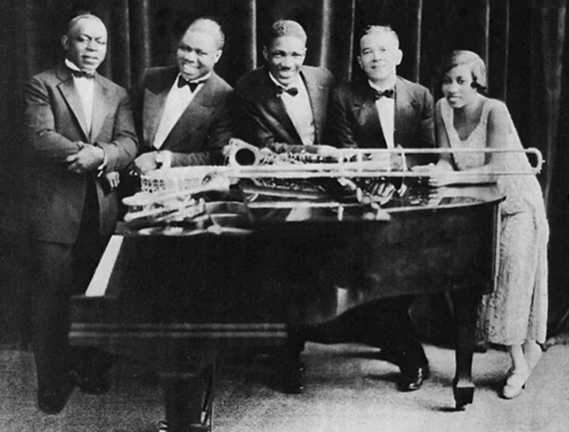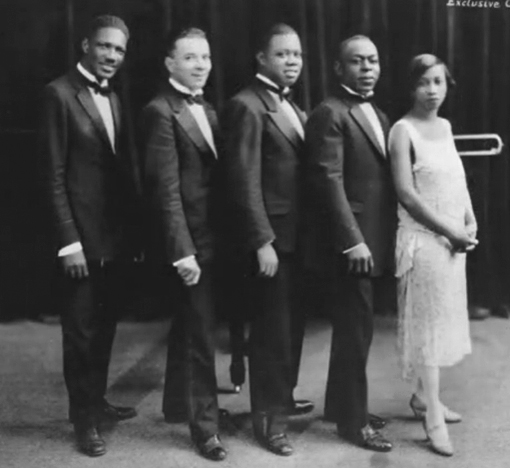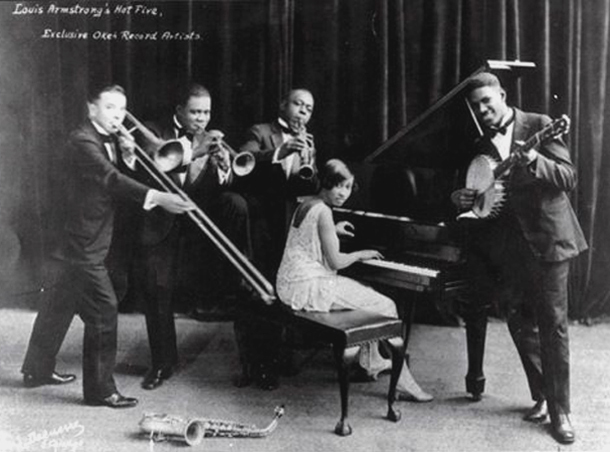Traditional jazz: “Cornet Chop Suey”, “Struttin’ With Some Barbecue”, “Willie The Weeper”, “Twelfth Street Rag”, “Weary Blues” and “Potato Head Blues”
(Edited)
Cornet Chop Suey
Louis Armstrong and His Hot Five: Louis Armstrong (trumpet), Kid Ory (trombone), Johnny Dodds (clarinet), Lil Hardin Armstrong (piano) and Johnny St. Cyr (banjo) (1926).
At first, the music of the Louis Armstrong and His Hot Five followed the original jazz tradition based on collective improvisation, but due to the great creativity that Armstrong showed with the trumpet, his solos appeared more and more frequently, and in them he laid down the basic language of solo improvisation in jazz. The Chicago style liberated the soloist from the chains of contrapuntal improvisation and allowed other leading instruments, giving greater freedom to create melodic lines. Also the two-beat rhythm in which the older jazz was based changed to four-beat replacing the sousaphone with the double bass to provide the bass lines.

Louis Armstrong and His Hot Five
Armstrong is second from the left
Armstrong used the new freedom to accentuate the second and fourth beats and anticipating the main beats with lead-in notes in his solos to create a sense of rhythmic pulse that happened between the beats as well as on them, giving rise to what was then called “syncopation” and later on “swing”. With his harmonic complexity, his virtuoso range and his drive on the trumpet, he firmly established himself as the foremost innovator of the music. This is clearly heard in “Cornet Chop Suey” and “Struttin’ with Some Barbecue”, which can be found below.

Louis Armstrong and His Hot Five
Armstrong is third from the left
In May 1927 he organized the Louis Armstrong and His Hot Seven by adding Pete Briggs on tuba and Baby Dodds (brother of the clarinetist) on drums. Additionally, John Thomas replaced Kid Ory on trombone, who was touring at the time with King Oliver. This was possible because the Okeh label began making electrical recordings rather than acoustic ones. During that month they recorded twelve tracks, including the standard vaudeville song “Willie the Weeper”, the ragtime “Twelfth Street Rag” and “Weary Blues”, as well as the hit “Potato Head Blues”, written by Armstrong himself. Please, find all of them below. On these tunes Armstrong refined his mastery of the jazz solo further cracking the New Orleans jazz style into a vehicle for the soloist.

Louis Armstrong and His Hot Five
Armstrong is second from the left


Struttin’ With Some Barbecue
Louis Armstrong and His Hot Five: Louis Armstrong (trumpet), Kid Ory (trombone), Johnny Dodds (clarinet), Lil Hardin Armstrong (piano) and Johnny St. Cyr (banjo) (1927).

Willie The Weeper
Louis Armstrong and His Hot Seven: Louis Armstrong (trumpet), John Thomas (trombone), Johnny Dodds (clarinet), Lil Hardin Armstrong (piano), Johnny St. Cyr (banjo), Pete Briggs (tuba), “Baby” Dodds (drums) (1927).

Twelfth Street Rag
Louis Armstrong and His Hot Seven: Louis Armstrong (cornet, vocals), John Thomas (trombone), Johnny Dodds (clarinet), Lil Hardin Armstrong (piano, vocals), Johnny St. Cyr (banjo), Pete Briggs (tuba), “Baby” Dodds (drums) (1927).

Weary Blues
Louis Armstrong and His Hot Seven: Louis Armstrong (trumpet), John Thomas (trombone), Johnny Dodds (clarinet), Lil Hardin Armstrong (piano), Johnny St. Cyr (banjo), Pete Briggs (tuba), “Baby” Dodds (drums) (1927).

Potato Head Blues
Louis Armstrong and His Hot Seven: Louis Armstrong (cornet), John Thomas (trombone), Johnny Dodds (clarinet), Lil Hardin Armstrong (piano), Johnny St. Cyr (banjo), Pete Briggs (tuba), “Baby” Dodds (drums) (1927).
0
0
0.000

Do you want to get involved? Do you want to support music and this project? Follow us to keep you updated and read our Introduction post!
Great. Eternal music. Thanks for sharing! 😎 👏
https://twitter.com/JavierCalduch2/status/1342897788074536962